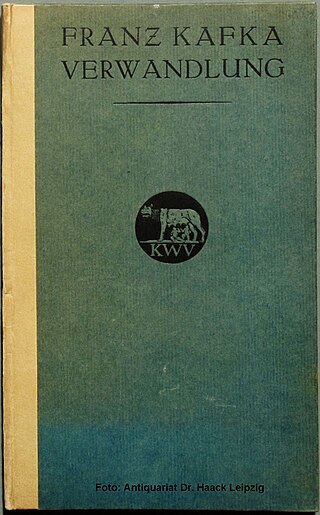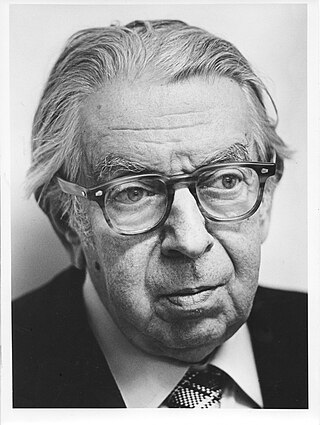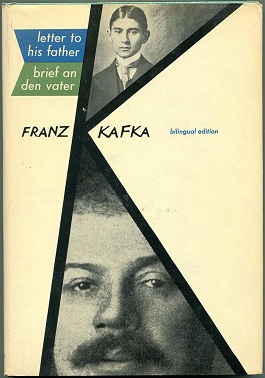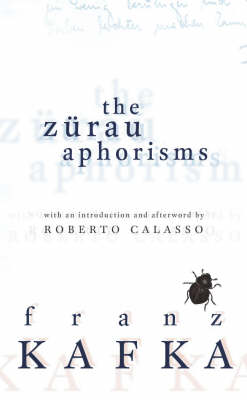
Franz Kafka was a German-speaking Bohemian novelist and short-story writer based in Prague, who is widely regarded as one of the major figures of 20th-century literature. His work fuses elements of realism and the fantastic. It typically features isolated protagonists facing bizarre or surrealistic predicaments and incomprehensible socio-bureaucratic powers. It has been interpreted as exploring themes of alienation, existential anxiety, guilt, and absurdity. His best known works include the novella The Metamorphosis and novels The Trial and The Castle. The term Kafkaesque has entered English to describe absurd situations like those depicted in his writing.

Metamorphosis is a novella written by Franz Kafka and first published in 1915. One of Kafka's best-known works, Metamorphosis tells the story of salesman Gregor Samsa, who wakes one morning to find himself inexplicably transformed into a huge insect and subsequently struggles to adjust to this new condition. The novella has been widely discussed among literary critics, who have offered varied interpretations. In popular culture and adaptations of the novella, the insect is commonly depicted as a cockroach.

"A Hunger Artist" is a short story by Franz Kafka first published in Die neue Rundschau in 1922. The story was also included in the collection A Hunger Artist, the last book Kafka prepared for publication, which was printed by Verlag Die Schmiede shortly after his death. The protagonist, a hunger artist who experiences the decline in appreciation of his craft, is typically Kafkaesque: an individual marginalized and victimized by society at large. "A Hunger Artist" explores themes such as death, art, isolation, asceticism, spiritual poverty, futility, personal failure and the corruption of human relationships. The title of the story has also been translated as "A Fasting Artist" and "A Starvation Artist".

Max Brod was a Bohemian-born Israeli author, composer, and journalist.

Amerika, also known as The Man Who Disappeared, The Missing Person and Lost in America, is the incomplete first novel by author Franz Kafka (1883–1924), written between 1911 and 1914 and published posthumously in 1927. The novel originally began as a short story titled "The Stoker". The novel incorporates many details of the experiences of his relatives who had emigrated to the United States. The commonly used title Amerika can be traced to the edition of the text put together by Kafka's close friend, Max Brod, after Kafka's death in 1924.

The Castle is the last novel by Franz Kafka. In it a protagonist known only as "K." arrives in a village and struggles to gain access to the mysterious authorities who govern it from a castle supposedly owned by Count Westwest.

"The Judgment", also translated "The Verdict", is a short story written by Franz Kafka in 1912, concerning the relationship between a man and his father.

Nahum Norbert Glatzer was an Austrian and American scholar of Jewish history and philosophy from antiquity to mid 20th century.
"Investigations of a Dog" is a short story by Franz Kafka written in 1922. It was published posthumously in Beim Bau der Chinesischen Mauer. The first English translation by Willa and Edwin Muir was published by Martin Secker in London in 1933. It appeared in The Great Wall of China. Stories and Reflections. Told from the perspective of a dog, the story concerns the nature and limits of knowledge, by way of the dog's inquiries into the practices of his culture.
"The Village Schoolmaster", or "The Giant Mole" is an unfinished short story by Franz Kafka. The story, written in December 1914 and the beginning of 1915, was not published in Kafka's lifetime. It first appeared in Beim Bau der Chinesischen Mauer. The first English translation by Willa and Edwin Muir was published by Martin Secker in London in 1933. It appeared in The Great Wall of China. Stories and Reflections.
"The Hunter Gracchus" is a short story by Franz Kafka. The story presents a boat carrying the long-dead Hunter Gracchus as it arrives at a port. The mayor of Riva meets Gracchus, who gives him an account of his death while hunting, and explains that he is destined to wander aimlessly and eternally over the seas. An additional fragment presents an extended dialogue between Gracchus and an unnamed interviewer, presumably the same mayor.
"A Little Woman" is a short story by Franz Kafka written between December 1923 and the end of January 1924. It was first published in the Easter supplement of Prager Tagblatt on 20 April 1924. During his final illness Kafka corrected the proofs of the story for the inclusion into collection A Hunger Artist published by Verlag Die Schmiede after his death.

Letter to His Father is the name given to a letter Franz Kafka wrote to his father, Hermann, in November 1919.

Franz Kafka, a German-language writer of novels and short stories who is regarded by critics as one of the most influential authors of the 20th century, was trained as a lawyer and later employed by an insurance company, writing only in his spare time.
"The Helmsman" is a short story by Franz Kafka, written sometime between 1917 and 1923. The story deals with a man who is deposed from his role as a helmsman and complains that his shipmates refuse to help him regain his rightful position.
"The Married Couple" is a 1922 short story by Franz Kafka. It was published posthumously in Beim Bau der Chinesischen Mauer. The first English translation by Willa and Edwin Muir was published by Martin Secker in London in 1933. It appeared in The Great Wall of China. Stories and Reflections.
"The Bucket Rider" is a short story by Franz Kafka, written in 1917. It first appeared in the Prager Presse in 1921 and was published posthumously in Beim Bau der Chinesischen Mauer. The first English translation, by Willa and Edwin Muir, was published by Martin Secker in London in 1933. It also appeared in The Great Wall of China. Stories and Reflections.

A Hunger Artist is the collection of four short stories by Franz Kafka published in Germany in 1924, the last collection that Kafka himself prepared for publication. Kafka was able to correct the proofs during his final illness but the book was published by Verlag Die Schmiede several months after his death.

The Zürau Aphorisms are 109 aphorisms of Franz Kafka, written from September 1917 to April 1918 and published by his friend Max Brod in 1931, after his death. They are selected from his writing in Zürau in West Bohemia where he stayed with his sister Ottla, suffering from tuberculosis. His friend Max Brod titled the book "Betrachtungen über Sünde, Hoffnung, Leid und den wahren Weg".
"My Neighbor" is a short story by Franz Kafka. It was written in 1917 and published in 1931 in Berlin by Max Brod and Hans-Joachim Schoeps. The first English translation by Willa and Edwin Muir was published by Martin Secker in London in 1933. It appeared in The Great Wall of China. Stories and Reflections.










